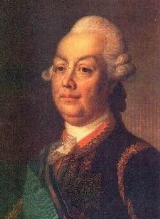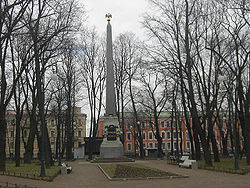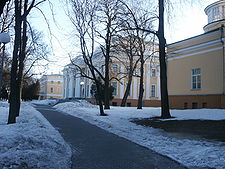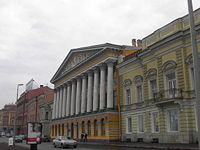
Pyotr Rumyantsev
Encyclopedia
Count Pyotr Alexandrovich Rumyantsev-Zadunaisky (15 January 1725 – 19 December 1796) was one of the foremost Russia
n generals of the 18th century. He governed Little Russia
in the name of Empress Catherine the Great from the abolition of the Cossack Hetmanate
in 1764 until Catherine's death 32 years later. Monuments to his victories include Kagul Obelisk
in Tsarskoe Selo (1772), Rumyantsev Obelisk on Basil Island
(1798–1801), and a galaxy of Derzhavin's odes.
by Maria
, the daughter and heiress of Count Andrey Matveyev
. As his mother spent much time in the company of Peter the Great, rumours suggested that the young Rumyantsev was the monarch's illegitimate son. He was named after the ruling Emperor who was his godfather. He was the brother of Praskovja Bruce, confidant of Catherine the great.
Pyotr Alexandrovich first saw military service under his nominal father in the war with Sweden (1741 - 1743). He personally carried to the Empress the peace treaty of Abo
, concluded by his father in 1743. Thereupon he gained promotion to the rank of colonel.
His first military glory dates from the great battles of the Seven Years' War
(1756 - 1763), those of Gross-Jägersdorf
(1757) and Kunersdorf
(1759). In 1761 he besieged and took the Pomeranian fortress of Kolberg, thus clearing for Russian armies the path to Berlin
.
 Throughout the reign of Catherine the Great
Throughout the reign of Catherine the Great
, Rumyantsev served as supreme governor of Ukraine
. In this post, which his father had held with so much honesty, Rumyantsev made it his priority to eliminate any autonomy of the hetman
s and to fully incorporate the newly-conquered territories into the Russian Empire
. Some accuse him of having promoted serfdom
in New Russia, but the choice of such a policy remained out of his control.
With the outbreak of the Russo-Turkish war
in 1768, Rumyantsev took command of the army sent to capture Azov
. He thoroughly defeated the Turks in the Battles of Larga
and Kagula
, crossed the Danube
and advanced to Romania
. For these dazzling victories he became Field-Marshal and gained the victory title
Zadunaisky (meaning "Trans-Danubian"). When his forces approached Shumla in 1774, the new Sultan Abdul Hamid I started to panic and sued for peace, which Rumyanstev signed upon a military tambourine at the village of Kuchuk-Kainarji
.
, allegedly regarded his fame with such jealousy that they wouldn't permit him to take the command again. In times of peace, Rumyantsev expressed his innovative views on the martial art in the Instructions (1761), Customs of Military Service (1770), and the Thoughts (1777). These works provided a theoretical base for the re-organisation of the Russian army undertaken by Potemkin.
During the Second Russo-Turkish War, Zadunaisky suspected Potemkin of deliberately curtailing supplies of his army and presently resigned his command. In the Polish campaign of 1794
he once again won appointment as commander-in-chief
, but his rival Suvorov actually led the armies into battle. On this occasion Rumyantsev didn't bother even to leave his Ukrainian manor at Tashan which he had rebuilt into a fortress. He died there on December 19, 1796, just over a month after Catherine's death, and was interred in the Kiev
Pechersk Lavra.
|+ Rumyantsev residences>



Kachanovka
Palace, Ukraine.
Governors' Palace
in Kiev
.
Rumyantsev Residence
in Gomel, Belarus
.
Nikolai Rumyantsev's mansion on English Quay, St. Petersburg.
As the story goes, old Rumyantsev-Zadunaisky grew enormously fat and avaricious, so that he pretended not to recognize his own sons when they came from the capital to ask for money. Under his son Sergey's administration, Tashan fell into ruins, although he erected a mausoleum
near Balashikha
for his father's reburial (which never took place). Neither Sergey nor his brother Nikolay Petrovich Rumyantsev married, and the comital branch of the Rumyantsev family
went extinct upon their death.
Russia
Russia or , officially known as both Russia and the Russian Federation , is a country in northern Eurasia. It is a federal semi-presidential republic, comprising 83 federal subjects...
n generals of the 18th century. He governed Little Russia
Little Russia
Little Russia , sometimes Little or Lesser Rus’ , is a historical political and geographical term in the Russian language referring to most of the territory of modern-day Ukraine before the 20th century. It is similar to the Polish term Małopolska of the Polish-Lithuanian Commonwealth...
in the name of Empress Catherine the Great from the abolition of the Cossack Hetmanate
Cossack Hetmanate
The Hetmanate or Zaporizhian Host was the Ruthenian Cossack state in the Central Ukraine between 1649 and 1782.The Hetmanate was founded by first Ukrainian hetman Bohdan Khmelnytsky during the Khmelnytsky Uprising . In 1654 it pledged its allegiance to Muscovy during the Council of Pereyaslav,...
in 1764 until Catherine's death 32 years later. Monuments to his victories include Kagul Obelisk
Kagul Obelisk
The Kagul Obelisk in Tsarskoye Selo is one of several such structures erected on behest of Catherine II of Russia in 1772 to commemorate Pyotr Rumyantsev's victory in the Battle of Kagul...
in Tsarskoe Selo (1772), Rumyantsev Obelisk on Basil Island
Vasilievsky Island
Vasilyevsky Island is an island in Saint Petersburg, Russia, bordered by the rivers Bolshaya Neva and Malaya Neva in the south and northeast, and by the Gulf of Finland in the west. Vasilyevsky Island is separated from Dekabristov Island by the Smolenka River...
(1798–1801), and a galaxy of Derzhavin's odes.
Early life
Peter was the only son of Count Alexander RumyantsevAlexander Rumyantsev
Count Alexander Ivanovich Rumyantsev was an assistant of Peter the Great and father of Field Marshal Peter Rumyantsev-Zadunaisky. He came from the Rumyantsev family which, though little known and documented in the 17th century, later claimed descent from a prominent 14th-century boyar.Alexander...
by Maria
Maria Rumyantseva
Countess Maria Andreyevna Rumyantseva née Matveyeva was a Russian lady in waiting and alleged royal mistress of Tsar Peter the Great....
, the daughter and heiress of Count Andrey Matveyev
Andrey Matveyev
Count Andrey Artamonovich Matveev was a Russian statesman of the Petrine epoch best remembered as one of the first Russian ambassadors and Peter the Great's agent in London and the Hague....
. As his mother spent much time in the company of Peter the Great, rumours suggested that the young Rumyantsev was the monarch's illegitimate son. He was named after the ruling Emperor who was his godfather. He was the brother of Praskovja Bruce, confidant of Catherine the great.
Pyotr Alexandrovich first saw military service under his nominal father in the war with Sweden (1741 - 1743). He personally carried to the Empress the peace treaty of Abo
Treaty of Åbo
The Treaty of Åbo or the Treaty of Turku was a peace treaty signed between the Russian Empire and Sweden in Turku on 7. Augustjul./ 18. Augustgreg...
, concluded by his father in 1743. Thereupon he gained promotion to the rank of colonel.
His first military glory dates from the great battles of the Seven Years' War
Seven Years' War
The Seven Years' War was a global military war between 1756 and 1763, involving most of the great powers of the time and affecting Europe, North America, Central America, the West African coast, India, and the Philippines...
(1756 - 1763), those of Gross-Jägersdorf
Battle of Gross-Jägersdorf
The Battle of Gross-Jägersdorf was a victory for the Russian force under Field Marshal Stepan Fedorovich Apraksin over a smaller Prussian force commanded by Field Marshal Hans von Lehwaldt, during the Seven Years' War.- Background :...
(1757) and Kunersdorf
Battle of Kunersdorf
The Battle of Kunersdorf, fought in the Seven Year's War, was Frederick the Great's most devastating defeat. On August 12, 1759, near Kunersdorf , east of Frankfurt , 50,900 Prussians were defeated by a combined allied army 59,500 strong consisting of 41,000 Russians and 18,500 Austrians under...
(1759). In 1761 he besieged and took the Pomeranian fortress of Kolberg, thus clearing for Russian armies the path to Berlin
Berlin
Berlin is the capital city of Germany and is one of the 16 states of Germany. With a population of 3.45 million people, Berlin is Germany's largest city. It is the second most populous city proper and the seventh most populous urban area in the European Union...
.
First Russo-Turkish War

Catherine II of Russia
Catherine II, also known as Catherine the Great , Empress of Russia, was born in Stettin, Pomerania, Prussia on as Sophie Friederike Auguste von Anhalt-Zerbst-Dornburg...
, Rumyantsev served as supreme governor of Ukraine
Ukraine
Ukraine is a country in Eastern Europe. It has an area of 603,628 km², making it the second largest contiguous country on the European continent, after Russia...
. In this post, which his father had held with so much honesty, Rumyantsev made it his priority to eliminate any autonomy of the hetman
Hetman
Hetman was the title of the second-highest military commander in 15th- to 18th-century Poland and the Grand Duchy of Lithuania, which together, from 1569 to 1795, comprised the Polish-Lithuanian Commonwealth, or Rzeczpospolita....
s and to fully incorporate the newly-conquered territories into the Russian Empire
Russian Empire
The Russian Empire was a state that existed from 1721 until the Russian Revolution of 1917. It was the successor to the Tsardom of Russia and the predecessor of the Soviet Union...
. Some accuse him of having promoted serfdom
Serfdom
Serfdom is the status of peasants under feudalism, specifically relating to Manorialism. It was a condition of bondage or modified slavery which developed primarily during the High Middle Ages in Europe and lasted to the mid-19th century...
in New Russia, but the choice of such a policy remained out of his control.
With the outbreak of the Russo-Turkish war
Russo-Turkish War, 1768-1774
The Russo-Turkish War of 1768–1774 was a decisive conflict that brought Southern Ukraine, Northern Caucasus, and Crimea within the orbit of the Russian Empire.-Background:...
in 1768, Rumyantsev took command of the army sent to capture Azov
Azov
-External links:** *...
. He thoroughly defeated the Turks in the Battles of Larga
Battle of Larga
The Battle of Larga was fought between 65,000 Crimean Tatars cavalry and 15,000 Ottoman infantry under Kaplan Girey against 38,000 Russians under Field-Marshal Rumyantsev on the banks of the Larga River for eight hours on 7 July 1770. It was fought on the same day as Battle of Chesma, a key naval...
and Kagula
Battle of Kagul
The Battle of Cahul was the most important land battle of the Russo-Turkish War, 1768-1774 and one of the largest battles of the 18th century...
, crossed the Danube
Danube
The Danube is a river in the Central Europe and the Europe's second longest river after the Volga. It is classified as an international waterway....
and advanced to Romania
Romania
Romania is a country located at the crossroads of Central and Southeastern Europe, on the Lower Danube, within and outside the Carpathian arch, bordering on the Black Sea...
. For these dazzling victories he became Field-Marshal and gained the victory title
Victory title
A victory title is an honorific title adopted by a successful military commander to commemorate his defeat of an enemy nation. This practice was first used by Ancient Rome and is still most commonly associated with the Romans, but it has also been adopted as a practice by many modern empires,...
Zadunaisky (meaning "Trans-Danubian"). When his forces approached Shumla in 1774, the new Sultan Abdul Hamid I started to panic and sued for peace, which Rumyanstev signed upon a military tambourine at the village of Kuchuk-Kainarji
Treaty of Kucuk Kaynarca
The Treaty of Küçük Kaynarca was signed on 21 July 1774, in Küçük Kaynarca , Dobruja between the Russian Empire and the Ottoman Empire after the Ottoman Empire was defeated in the...
.
Second Russo-Turkish War
By that point, Rumyantsev had undoubtedly become the most famous Russian commander. Other Catharinian generals, notably PotemkinGrigori Alexandrovich Potemkin
Prince Grigory Aleksandrovich Potemkin-Tavricheski was a Russian military leader, statesman, nobleman and favorite of Catherine the Great. He died during negotiations over the Treaty of Jassy, which ended a war with the Ottoman Empire that he had overseen....
, allegedly regarded his fame with such jealousy that they wouldn't permit him to take the command again. In times of peace, Rumyantsev expressed his innovative views on the martial art in the Instructions (1761), Customs of Military Service (1770), and the Thoughts (1777). These works provided a theoretical base for the re-organisation of the Russian army undertaken by Potemkin.
During the Second Russo-Turkish War, Zadunaisky suspected Potemkin of deliberately curtailing supplies of his army and presently resigned his command. In the Polish campaign of 1794
Kosciuszko Uprising
The Kościuszko Uprising was an uprising against Imperial Russia and the Kingdom of Prussia led by Tadeusz Kościuszko in Poland, Belarus and Lithuania in 1794...
he once again won appointment as commander-in-chief
Commander-in-Chief
A commander-in-chief is the commander of a nation's military forces or significant element of those forces. In the latter case, the force element may be defined as those forces within a particular region or those forces which are associated by function. As a practical term it refers to the military...
, but his rival Suvorov actually led the armies into battle. On this occasion Rumyantsev didn't bother even to leave his Ukrainian manor at Tashan which he had rebuilt into a fortress. He died there on December 19, 1796, just over a month after Catherine's death, and was interred in the Kiev
Kiev
Kiev or Kyiv is the capital and the largest city of Ukraine, located in the north central part of the country on the Dnieper River. The population as of the 2001 census was 2,611,300. However, higher numbers have been cited in the press....
Pechersk Lavra.



Kachanovka
Kachanovka is one of the country estates of Pyotr Rumyantsev, Catherine II's viceroy of Little Russia. It stands on the bank of the Smosh River in Chernihiv Oblast of Ukraine. Other Rumyantsev estates in the region include the better known Gomel Residence.The Neoclassical residence was erected in...
Palace, Ukraine.
Mariyinsky Palace
Mariyinsky Palace is an official ceremonial residence of the President of Ukraine in Kiev and adjoins the neo-classical building of the Verkhovna Rada of Ukraine...
in Kiev
Kiev
Kiev or Kyiv is the capital and the largest city of Ukraine, located in the north central part of the country on the Dnieper River. The population as of the 2001 census was 2,611,300. However, higher numbers have been cited in the press....
.
Gomel Palace
The Rumyantsev-Paskevich Residence is the main place of historical importance in the city of Gomel, Belarus. The grounds of the residence stretch for 800 meters along the steep right bank of the Sozh River...
in Gomel, Belarus
Belarus
Belarus , officially the Republic of Belarus, is a landlocked country in Eastern Europe, bordered clockwise by Russia to the northeast, Ukraine to the south, Poland to the west, and Lithuania and Latvia to the northwest. Its capital is Minsk; other major cities include Brest, Grodno , Gomel ,...
.
As the story goes, old Rumyantsev-Zadunaisky grew enormously fat and avaricious, so that he pretended not to recognize his own sons when they came from the capital to ask for money. Under his son Sergey's administration, Tashan fell into ruins, although he erected a mausoleum
Mausoleum
A mausoleum is an external free-standing building constructed as a monument enclosing the interment space or burial chamber of a deceased person or persons. A monument without the interment is a cenotaph. A mausoleum may be considered a type of tomb or the tomb may be considered to be within the...
near Balashikha
Balashikha
Balashikha is a city in Moscow Oblast, Russia, located on the Pekhorka River east of Moscow. It is known for its unique river and waterway system. The Pekhorka River system covers an area of from north to south and from east to west, and many small lakes and ponds were created by damming to...
for his father's reburial (which never took place). Neither Sergey nor his brother Nikolay Petrovich Rumyantsev married, and the comital branch of the Rumyantsev family
Rumyantsev
The Rumyantsev family were Russian counts prominent in Russian imperial politics in the 18th and early 19th centuries. The family claimed descent from the boyar Rumyanets who broke his oath of allegiance and surrendered Nizhny Novgorod to Vasily I of Moscow in 1391.The first Rumyantsev to gain...
went extinct upon their death.
See also
- Operation Polkovodets RumyantsevOperation Polkovodets RumyantsevOperation Polkovodets Rumyantsev was a code name for the Belgorod-Kharkov Strategic Offensive Operation conducted by the Red Army between 3 August 1943 and 23 August 1943 against the Wehrmacht's 4th Panzer Army and Army Group Kempf during World War II. The operation was conducted by the Voronezh...

